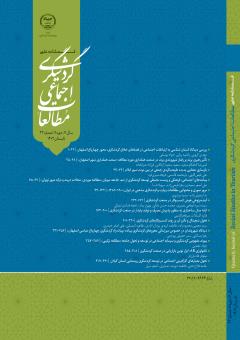آیندهپژوهی هوش کسبوکار در صنعت گردشگری
محورهای موضوعی : مطالعات اجتماعی و گردشگری، جامعه شناسی گردشگریسیده نیر ابطحی نصیری 1 , محمدحسن ملکی 2 , بهروز بیات 3 , تحفه قبادی 4
1 - دانشگاه آزاد اسلامی واحد همدان
2 - دانشگاه قم
3 - دانشگاه آزاد اسلامی واحد همدان
4 - استادیار گروه مدیریت، دانشگاه آزاد اسلامی، واحد گنید کاووس، ایران.
کلید واژه: آینده, آیندهپژوهی, هوش کسبوکار, صنعت گردشگری,
چکیده مقاله :
با وجود ظرفیتهای بالقوه گردشگری در کشور، به علت فقدان زیرساختها، موانع قانونی و تحریمهای خارجی، گردشگران خارجی کمی در مقایسه با کشورهای رقیب از ایران بازدید میکنند. یکی از روندهای مهم در این صنعت، رشد چشمگیر استفاده از ابزارهای فناوری اطلاعات در این حوزه است. تحقیق حاضر با هدف شناسایی سناریوهای آینده هوش کسبوکار در صنعت گردشگری ایران انجام شده است. تحقیق حاضر از نظر جهتگیری، کاربردی و از منظر هدف، اکتشافی است. همچنین از روشهای کیفی و کمی برای تحلیل دادهها استفاده شد. جامعه نظری پژوهش، خبرگان گردشگری، آیندهپژوهی و هوش کسبوکار بودند و نمونهها با استفاده از روش نمونهگیری قضاوتی انتخاب شدند. تحقیق در سه مرحله انجام شد. در گام اول، پیشرانهای مؤثر روی آینده هوش کسبوکار در گردشگری از طریق مرور پیشینه و اخذ نظر از خبرگان، بدست آمد. در مرحله بعد، 30 پیشران بدست آمده غربال و بعد با ایداس، اولویتبندی شدند. در ابتدا پیشرانها با آزمون دوجملهای غربال شدند و 20 پیشران از تحلیل حذف شد. 10 پیشران باقیمانده با ایداس، ارزیابی و دو پیشران نوع فرهنگ تصمیمگیری و ورود گردشگران خارجی به عنوان پیشرانهای نهایی، انتخاب شدند. بر اساس پیشرانهای نهایی و کاربست ابزار تعاریف ریشهای و کارگاه هماندیشی، چهار سناریو با اسامی عصر شکوفایی، عصر ناهمسانی، خانه عنکبوت و عصر یخی پرورش یافت. سناریوهای عصر شکوفایی و عصر یخی، بهترتیب بهترین و بدترین شرایط را در مورد آینده هوش کسبوکار در گردشگری به تصویر میکشند.
Despite potential tourism capacities in Iran, few foreign tourists visit Iran compared to the competing countries due to the lack of infrastructure, the existence of legal barriers, and the sanctions imposed against Iran. As considerable growth in the application of information technology to tourism is one of the main trends in this industry, this applied exploratory study sought to identify future scenarios of business intelligence in Iran’s tourism industry using both qualitative and quantitative methods to analyze the collected data. The population of the study comprised tourism, future study, and business intelligence experts, out of whom the intended participants were selected via judgmental sampling. The study was conducted in three phases. In the first phase, thirty effective driving forces of the prospective business intelligence in the tourism industry were identified by reviewing the related literature and interviewing the experts. In the next phase, the identified driving forces were screened and prioritized using the EDAS. To this end, the driving forces were screened via the Binominal test, twenty of which were eliminated from the analysis, accordingly. Then, the remaining ten driving forces were assessed using the EDAS method. Finally, the type of decision-making culture and the arrival of foreign tourists were selected as the final driving forces, which, together with the application of root definitions and the organization of consultation workshop, formed the basis of offering four scenarios, namely the prosperity, heterogeneity, the spider web, and the ice ages. Accordingly, the prosperity and ice age scenarios illustrate the best and worst conditions for the future of business intelligence in tourism, respectively.
